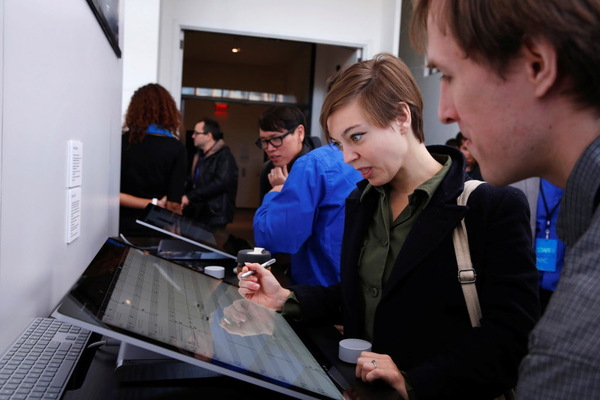How Surface devices have radically transformed Microsoft

Apple versus Microsoft. Mac versus PC. That’s not how our “brief” four-decades-old history of commercial computing started.
The late 1970s have seen radical new ideas, coming to light, slowly as it were, yet destined to change the lifestyle and mindset of people around the world, and rivalries were seen as trivial in a world where information technology was, to the person on the street, but a concept, first introduced in 1949 by a June edition of British newspaper The Star, about EDSAC, the “Electronic Delay Storage Automation Calculator”: only the second electronic digital stored-program computer to begin regular service, as its predecessor, EDVAC was just about to be declared obsolete, after 3 years of service as military ordinance, as result of a contract between the U.S. Army’s Ordnance Department and the University of Pennsylvania, in 1945.
Not nearly 40 years later, Apple manufactures its first Macintosh, named after a popular apple type, but spelled differently, to avoid copyright disputes.
Within the same time period, IBM moves onto manufacturing computers for the masses, powered by Intel 80 CPUs, and running the very first version of Microsoft Windows, one of the first sporting a rudimentary graphical user interface, designed for users who have never seen a computer before.
As Microsoft Windows evolved, so did Mac OS, until both Microsoft and Apple hit a turning point in 1997, when popularity reached its first peak, and the world was officially in love with the personal computer.
That was also the year when Apple and Microsoft officially began their love-hate relationship, when Bill Gates was booed at Apple’s first Macworld keynote, as Steve Jobs announced Microsoft’s involvement in keeping Apple afloat.
To those who were part of early computing culture, especially as computers evolved from scientific instruments, into household appliances, feudal sentiment was a natural consequence, something that would be hard to feel today. Back then, loyalty was to the technology itself, the operating system, the hardware, rather than the brand, which is what technology is all about in this day and age.
Hardware is streamlined and interchangeable, as the industry set its sight on raw elements, like speed, performance, endurance and design.
Windows PC hardware in the 90s was ugly, mis-shaped, and engineered to collect dust at a formidable rate. If you ever opened an IBM PS/1 80386 after a few months of usage, you could barely see the green on the logic board, under the thick, layer of particles sucked in by the rear vent of its heavy, stainless steel case, buried under a desk, or between furniture, and never, ever in plain sight. Barely noticeable unless one pays attention to the whirring noise, or the little green LEDs.
Windows PCs were never the prettiest machines, but that’s now why Windows users loved them. They were affordable, and accessible by regular folks. Thanks to Windows PCs, every household was at least somewhat computer literate by the late 1990s, which represented a huge social change. Young people exposed to PCs were more likely to pursue IT-related careers, in engineering, programming and design, which contributed to a rise of tech companies by the end of the 1990s. Companies like Google, Facebook, Twitter, and Tesla Motors would have never seen the light of day without the early influence of PCs.
Windows 95, 98, NT, all the way up to Windows XP, were the easiest operating systems to get familiar with the basics of computing. They were a training ground for millions of users who now understand what computers are for.
Apple computers were no less user friendly, in fact they offered a superior experience, if it weren’t for the higher price tag, which would turn into Apple’s primary selling point, and primary appeal.
Fast forward to 2017, Apple and Microsoft have changed radically. Computing has evolved in such way that users no longer need coaching, partly because machines are no longer forcing users to learn “their language”. Computers can be talked to, asked questions, and advances in AI allow machines to be ready to provide information to users, even before they ask, by analyzing predictive patterns, from the typical time we leave for work, to how often we buy a particular grocery item.
This is the perfect time for Microsoft to stop being a computing’s “training wheel”, and move on to become every bit the commercially driven behemoth Apple strived to be.
The Microsoft Surface brand, started almost by accident. A name that stuck from the original Microsoft Surface table, or PixelSense, named after the technology now behind all commercially available Surface touch devices.
Thin design, quality craftsmanship, sleek, brushed machined aluminum enclosures, and a keen eye on user experience are no longer Apple’s exclusive domain, since Microsoft unveiled Surface Book, the company’s first real MacBook competitor.
With that said, Microsoft core user base is still a priority, even as new devices begin to colonize a Microsoft pantheon of high-end, high-priced computers, catering to creative professionals, first and foremost.
Microsoft’s emphasis on holographic technology and VR is leading the way towards making virtual reality, and augmented reality as mainstream as Windows PCs became, by the end of the 1990s, by making it affordable, just as Windows PCs were, compared to Apple Macintosh computers, in the beginning of the personal computer age.
Ready to shop?
PortableOne has the best deals on Microsoft Surface Book laptops, and more powerful devices for work and downtime.